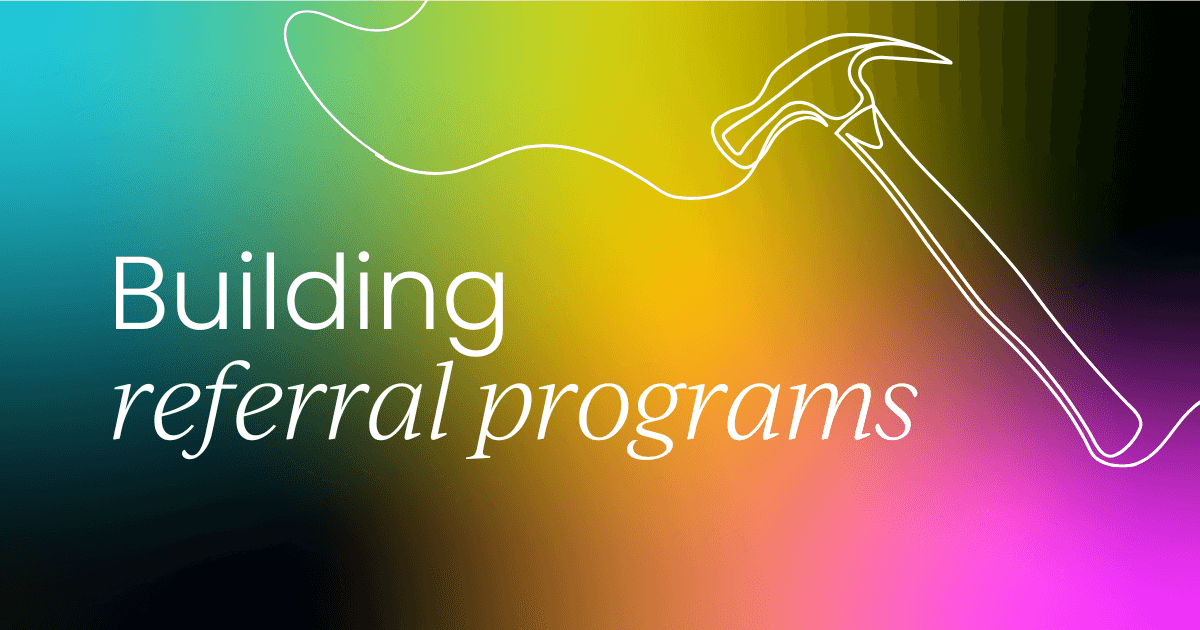If I asked you to think of the last time you bought something because a friend recommended it, I’m willing to bet the answer would come to you immediately.
Whether it was a restaurant, a pair of running shoes, or even a piece of software, that decision was probably rooted in something much deeper than flashy ads or clever copy. It was rooted in trust.
That’s the essence of referrals. They cut through noise, skepticism, and indecision, and they do it because people trust people more than they trust brands.
Yet despite their proven impact, most companies treat referrals like a nice-to-have instead of the strategic growth lever they really are.
That’s why I created the Customer Referrals Masters Certification: to help teams turn customer advocacy into a reliable, scalable engine for growth. I’ve spent two decades helping enterprise clients grow across industries like payments, logistics, and SaaS. What I’ve learned is this: referrals don’t just happen – they’re built.
And if you want your referral program to work, you need to do a whole lot more than plug in some software and hope for the best.
Let me walk you through what makes referrals so powerful, how to build a referral program that actually delivers and, critically, what happens after launch if you want to keep the engine running.
Why referrals are so much more than a “nice bonus”
Let’s start with the fundamentals: Referrals work because they’re built on trust. We trust our peers. We trust people with shared experiences. And when someone we know and respect recommends something, we listen.
In fact, according to Edelman’s Trust Barometer, 84% of B2B buyers say they begin their buying journey with a referral. That’s before they visit your website. Before they see an ad. Before they hear from a rep.
And it’s not just about awareness. Referral customers tend to:
- Convert faster
- Spend more
- Stay longer
- Churn less
They’re more loyal because they come into the relationship with a positive association already established. They didn’t just find you – they were invited in by someone they trust.
But here’s the catch: most businesses don’t have a system in place to consistently harness this power. They rely on “organic” referrals and hope their customers will share out of sheer goodwill.
Hope isn’t a strategy.
Step 1: Build a referral program with intention
If you want referrals to become a meaningful part of your growth engine, you have to treat them with the same level of rigor you’d apply to sales or marketing. That starts with a plan.
Set clear goals and metrics
Before you design a single landing page or write a single line of copy, you need to define what success looks like. Ask yourself:
- Are we trying to increase customer acquisition?
- Do we want higher-quality leads?
- Are we aiming to reduce CAC or boost retention?
- Are we trying to grow in a specific segment or region?
The answers to these questions will shape everything else, from your incentive structure to the tools you use to measure performance. Common metrics include:
- Referral participation rate
- Conversion rate of referred leads
- Cost per acquisition from referrals
- Customer lifetime value of referred customers
- Return on investment (ROI)
- Platform/channel performance (i.e., where referrals originate)
Without clearly defined goals and a way to measure them, you’re flying blind.
Know your audience and ask what motivates them
Your customers aren’t all the same. What motivates a solo freelancer won’t move the needle for a Fortune 500 exec.
Use NPS surveys, customer interviews, or behavioral data to understand who’s most likely to refer – and why. Ask your happiest customers what kind of incentives would genuinely excite them. You don’t have to guess.
If you’re in a B2B environment, leverage regular touchpoints like QBRs or customer success check-ins. These are golden opportunities to both identify potential referrers and gather feedback on what would motivate them.
In a B2C context, emails, in-app messages, or post-purchase surveys work well. Just keep it short, relevant, and conversational.
Design the right incentives
This is where a lot of referral programs fall flat. Either the rewards are too small to care about, or they’re overly transactional and fail to build any real loyalty.
There are a few common models to choose from:
- One-sided: Only the referrer gets rewarded
- Two-sided: Both referrer and referred receive something
- Gamified: Rewards are tiered, competitive, or progress-based
You’ve got one-sided programs, which are simpler and cheaper to run. Then there are two-sided programs, which often deliver higher engagement. Gamified programs, while more complex, can drive sustained participation, especially in B2C environments.
Your incentives don’t have to be cash-based. In fact, in some industries, they legally can’t be. Options include:
- Discounts or account credits
- Free products or upgrades
- Charitable donations in the customer’s name
- Early access to new features
- Public recognition (think leaderboards or customer spotlights)
The best programs often mix a few of these, depending on the customer segment.
Step 2: Make the experience effortless
Even if someone loves your brand, they’re unlikely to jump through hoops to refer a friend. The process has to be seamless.
Here’s what matters:
Make it easy to find and share
- Add prominent, intuitive buttons in your app, dashboard, or emails
- Offer pre-written messages that customers can personalize
- Ensure referral links are easy to copy and share across social, email, and messaging apps
Dropbox is a classic example of this done right – they added a simple “Invite friends” button with a pre-filled message. One click, and you’re done.
Communicate clearly
Customers should instantly understand:
- How to refer
- What’s in it for them (and their friend)
- When and how rewards will be delivered
Use plain language and keep instructions to three steps or fewer. Airbnb nailed this with a simple, “Invite friends → They travel → You earn credit” format.
Zendesk is another great example, especially in the B2B space. Their referral page clearly outlines the program, includes FAQs, and provides everything a customer needs to feel confident referring.
Incentivize and personalize
You already know the importance of good incentives. But they need to be paired with relevance.
Intercom, for example, offers bill credits for referred customers – perfect for a SaaS context. Tesla plays to its community’s love of innovation with rewards like exclusive merch or limited-time perks.
Tailor the experience. Segment your customers. Offer different incentives for different tiers or user types.
Step 3: Engage, evolve, repeat
Once your program is live, the work isn’t over. This is where it begins.
Referral programs are not “set it and forget it.” Without consistent attention, even the best program will fade into the background. Here’s what to do next.
Build referral triggers into the customer journey
The best time to ask for a referral? Right after a moment of value.
That could be:
- A successful onboarding or implementation
- A glowing support experience
- A contract renewal
- A milestone (1-year anniversary, 100th purchase, etc.)
- A positive NPS response
Don’t just drop a CTA into your footer and hope for the best. Ask when the moment is right. Uber does this well, prompting users to refer after a positive ride experience.
Empower your internal teams
Sales and customer success are often your referral MVPs. They’re the ones who know your customers best, track satisfaction, and can time the ask perfectly.
Train these teams to:
- Identify happy, referral-ready customers
- Introduce the program naturally during check-ins
- Use templates and tools to simplify the ask
- Track and report referrals through your CRM
HubSpot’s CSM team is a great example. They introduced referral conversations into their onboarding and QBR process, resulting in a 30% increase in referral leads over a single quarter.
And they did it without financial incentives for the team – just alignment, enablement, and visibility.
Collect feedback and optimize
Your referral program should evolve just like any other part of your GTM strategy. Regularly analyze:
- Which channels generate the most referrals?
- What incentive structures drive the best conversion rates?Are referred customers as loyal as direct-acquired ones?
- Where are people dropping off in the process?
Test new CTAs. A/B test referral messages. Rotate seasonal incentives. Keep the program fresh and responsive to customer behavior.
Nurture community and advocacy
At the heart of every great referral program is a strong emotional connection. People refer when they feel seen, valued, and part of something meaningful.
That means referrals don’t live in isolation. They’re often the outcome of broader advocacy efforts, like communities, customer advisory boards, and recognition programs.
Your most passionate advocates are your most powerful growth engine. Don’t just reward their referrals – celebrate their impact, invite them into product conversations, and treat them like the partners they are.
Final thoughts: It’s not about luck, it’s about leverage
Referrals aren’t magic. They’re a measurable, repeatable part of a modern go-to-market strategy – if you build them that way.
That’s what the Customer Referrals Masters Certification is all about.
In this course, I guide you step by step through designing, launching, optimizing, and scaling a referral program that actually delivers results.
Across six comprehensive modules, we dig into the full lifecycle of a referral strategy – from foundational principles to real-world implementation.
Whether you’re building a program from scratch or looking to level up an underperforming one, this course has it all:
- Learn from real companies that actually made it work
- Get hands-on practice so you can use this stuff right away
- Create a framework that gets your goals, metrics, and incentives working together
- Use our tested playbooks to set up programs for B2B and B2C
- Help your sales and CS teams succeed with what they need
- Handle legal and compliance without the headaches
- Track what's working, build your community, and grow without breaking things
So, if you’re ready to stop treating referrals like a side project – and start turning them into a strategic growth engine – I’d love to work with you.
Join the Customer Referrals Masters Certification and start turning trust into traction.


 6 min read
6 min read
 Follow us on LinkedIn
Follow us on LinkedIn



